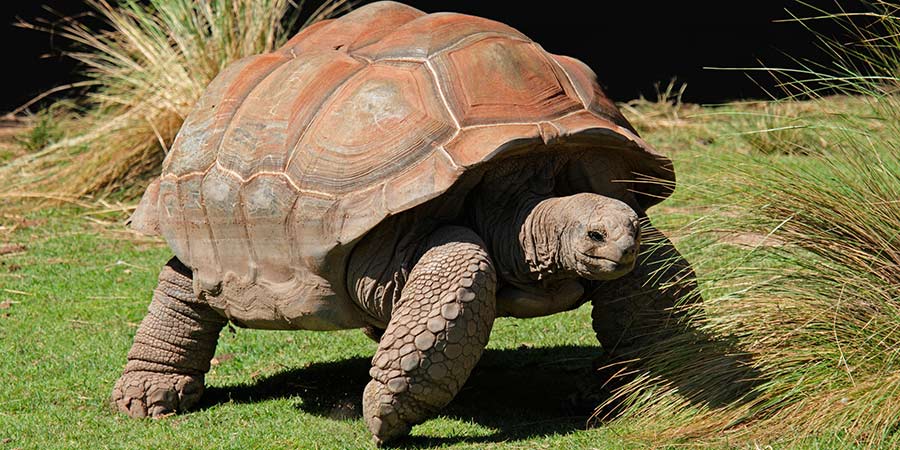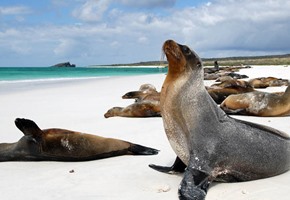We may be writing this on Valentine's Day, a celebration of inter-human love in many countries across the world, but we think that this week Darwin Day's message of love and respect for the planet and all the creatures that call this incredible Earth home, is far more important as we face an ever-more environmentally unstable future.
In a time when there are still institutions that won't teach Darwin's theories of natural selection (alongside it's perfect partner, random genetic mutation) instead favouring ideas of creationism, we're taking the time to honour the unique animals of the Galápagos Islands that helped inspire the game-changing, 'On the Origin of Species'.
1) - The blue-footed booby. Put on your blue-footed booby shoes and marvel at these adorable sea birds which resemble a cross between a seagull and an albatross but with one significant difference, their bright turquoise feet. Blessed with a wing-span of up to five feet they're not insignificant in size, but their slightly bumbling characteristics have meant they're forever stuck with a name implying a lack of intelligence (European colonists in South America named them after the Spanish word for stupid - bobo). They may look ungainly on the land, but they're perfectly adapted to life on the open seas, and can plunge majestically into the water from 80 feet above the surface to expertly catch their fish dinners. Then there's the males' unique mating dance, which you can see clearly on the Galápagos Islands at the right time of year, as much of the wildlife in this remote region hasn't been conditioned to fear humans. Its endearing strut as it tries to impress females may, in human terms, resemble typical dad dancing, but in the bird world it's busting some serious moves. And they seem to be doing the trick as the blue-footed booby is thriving on the Galápagos.
2) - The marine iguana. Perhaps not the prettiest of animals (Darwin himself pronounced the marine iguana as, 'hideous, stupid, and sluggish') they are evolutionary marvels that can only be found on the Galápagos Islands and are the only documented lizards that have gone through a process known as aquatic adaption. Having drifted across the ocean from surrounding landmasses as plain old iguanas, they had to adjust to underwater life in order to survive, eventually developing small snouts (which often make them look like they have a bit of a…habit as they become encrusted with salt from snuffling around in sea water) and sharp teeth to scrape algae off submerged rocks, as well as long claws for clinging to hard surfaces in strong currents and laterally flattened tails which they use like a propeller.
3) - Galápagos finches. One of the most important species Charles Darwin brought back with him from his research trips were these medium-sized passerine birds (although he had yet to realise it). What he thought were thirteen different species of bird, where in fact all part of the finch family, yet each one was markedly different from the next. These differences were most evident when it came to the bird's beaks, with some possessing almost parrotesque bills while others sported more traditional songbird type mandibles. Each one however was perfectly suited for collecting the main food its owner survived on, a huge clue to how evolution has helped all of us adapt to the specific environments within which we live.
4) - Galápagos penguin. Endemic to this archipelago and predominantly found along the craggy shores of Bartolomé Island, this particular breed of penguin is unusual for being the only one to live north of the equator (the Galápagos are absolutely awash with animal anomalies), and is much smaller than its more southern dwelling cousins. They spend their days alternating between agile underwater fishing, followed by rest periods stretched out to dry on the boulders that mark the point where land meets sea. At night-time, with an absence of burrowable surfaces, they retreat underground into naturally formed caves and crevices. Like all penguins, they mate for life and breeding success relies heavily on the conditions of their natural habitat, unfortunately for the penguins of the Galápagos Islands however, their homes have come under threat from environmental changes that are heavily linked to climate change, meaning they are sadly now considered to be an endangered species.
5) - Galápagos giant tortoise. Probably the most famous indigenous creature in all of the Galápagos, these incredible chelonians can reach a whopping 4 feet 3 inches in length and are thought to have been native to this part of the world for around 2-3 million years, making them truly living prehistory. The only other destination where they can be found is the isolated atoll of Aldabra in the Indian Ocean, though they once roamed widely throughout South America. They ended up floating over from the mainland on rafts of vegetation and lived secluded lives for millennia before humans came along to gawp at them. This segregation is believed to be what has led to them being so large in comparison to other turtle and tortoise species, a phenomenon known as island gigantism. This may be because there was so little competition for their main food source, or the exact opposite!
International Darwin Day was started by three Darwin enthusiasts with the intention to, 'inspire people throughout the globe to reflect and act on the principles of intellectual bravery, perpetual curiosity, scientific thinking, and hunger for truth as embodied in Charles Darwin'. Its message has become ever more prevalent in the 23 years since its inception, and we hope this blog has piqued your own hunger for truth - call today to find out more about a future adventure to the Galápagos Islands with Great Rail Journeys.





